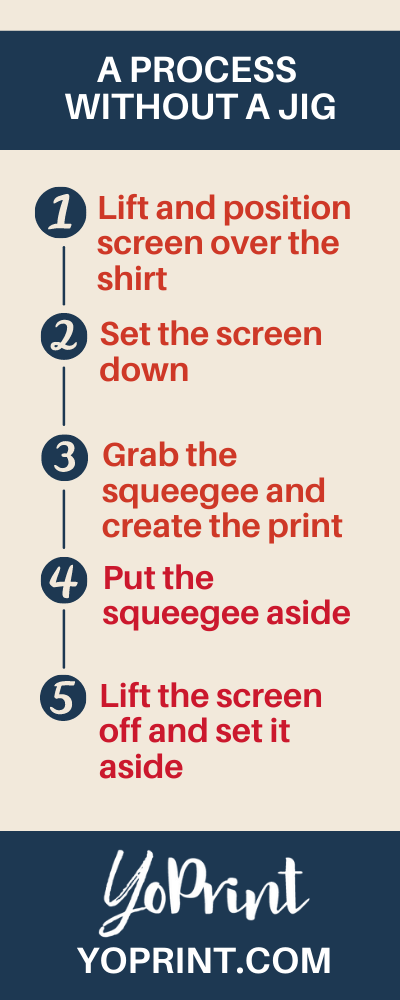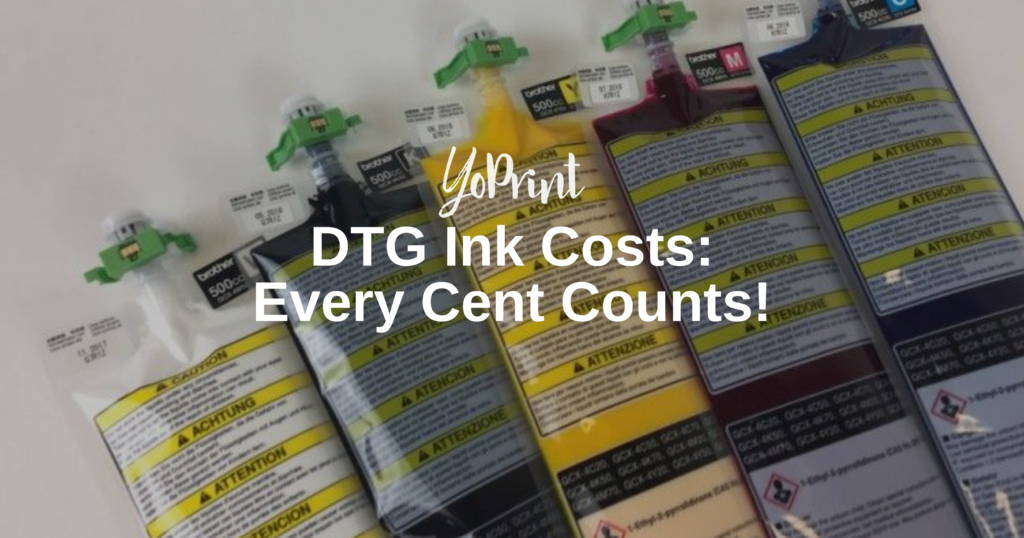Have you ever wondered how many shirts you could screen print in just one hour?
If you’re thinking of starting up a screen printing business, you’re going to need to know – but it isn’t as simple as just finding a number and knowing that you will always be able to complete that amount in the given time span.
The screenprint shirt’s speed will vary a lot and depends upon many different factors. You will need to be aware of these in order to effectively cost and manage jobs, because unless you can calculate roughly how long a job will take you, you can’t possibly manage your time or customers, or know when you can take on new work and when you’re fully booked.
We’re going to look at all the factors that affect the speed at which you can screen print shirts and also discuss how the cost of screen printing per shirt can vary as well.
We’ll touch on all the variables so you can start making accurate assessments of both your time and your finances.
You may be able to do 100 shirts in as little as an hour in the right conditions.
Factors Influencing The Screen Printing Speed
The speed at which you can print is going to massively affect how well your business runs and how much turnover you can establish. If you can’t print quickly, you aren’t going to have a business – and what’s why it’s important to think about this beforehand.
Knowing what will affect your speed will help you to calculate your costs and capacity, and will also help you look at any bottlenecks so you can consider whether there are solutions that will help you overcome them and speed up production.
Let’s talk about what influences your screen printing speed.
Type Of Item Being Printed
We’re looking at screen printing shirts predominantly, but you should be aware of how printing on different items will affect the speed.
If somebody asks you to screenprint on a hat, it’s going to take longer than screen printing on something totally flat, like a shirt.
Screen printing on balloons and other materials may take longer, but even just printing on a shirt with pleats, buttons, long sleeves, a v-neck, or other alterations will change how long it takes, because you will have to spend time arranging the fabric before you can print, and lining the screen up.
That may sound like just a few seconds, but remember that you will have to do it for every single color and every single print. Those seconds – even just a few of them – add up into minutes and hours very quickly.
Make sure you take into account what type of item your client wants you to print onto, and that you have an understanding of how long it will take before you cost the job.
Size Of Design And Screen

You will also have to think about the size of the design and the screen that you’re using to print. A very large screen is going to be more awkward to move around, and it will also be heavier, making it slower to lift and place.
Small designs will be faster because the screens are easier to lift and position.
Be aware of how complicated the design is and how large it is going to be when costing a job, as you might be surprised at how much longer it takes to lift and maneuver larger screens.
Number Of Colors Per Design

The number of colors that your client wants you to use will probably be one of the biggest factors when it comes to how fast you can screen print your shirts (or other items).
Remember that in screen printing, every color must be added as a separate layer and that each layer must be given time to dry in between, or you run the risk of ink smudging.
If your designs are just a single color, you will find that screen printing is both massively simpler and faster.
You can do a single color shirt in just seconds (discounting how long it takes to design the stencil), and can keep printing on multiple shirts very quickly, making this a surprisingly fast process.
However, as soon as you add another color into the equation, you are adding a lot more complexity.
Instead of setting a shirt aside to dry and then considering it “done” in terms of printing, you’re going to have to set it aside to dry, and then bring it back to your work area once it has dried.
You are also going to have to wait for it to dry – which means you’ll have to find something else to do in the interim.
If you haven’t got a lot of space to lay shirts out while they dry, this can prove frustrating, as you won’t be able to just keep printing more in the meantime.
Even once the shirt is dry, you are essentially back at the start; you are now printing the shirt again, and once more setting it aside to dry.
The more colors you have, the slower this process gets
Every time you need to allow for moving the shirt to a drying space, bringing it back, re-arranging it, etc.
You also need to think about how adding colors increases your other time commitments.
After all, you are going to need to clean and dry the screens, and then allow them to fully dry. You will need more screens to cope with the increased demand, which means more storage space and more setup costs.
It may sound surprising, but adding even one color can dramatically slow down your process and make it hard to print efficiently.
Fortunately, screen printing thrives on bold, simple colors, but you should absolutely take color requirements into account when thinking about printing speeds and what you need to charge clients.
Using A Jig Or Manual Registration
Using a jig will also massively alter how long a screen print takes and can mitigate some of the things that slow it down, such as changing color.
A jig will hold the screen above the T-shirt, and then lower it into the correct position when you are ready to apply the print.
You will need less space around your area for placing screens, and you can also keep your squeegee on the jig, meaning you won’t accidentally put it down somewhere and have to spend time searching; it will always be waiting just where you need it, besides the screen.
You won’t have to find somewhere to put it down when you’ve finished, either; it can just be dropped back on the jig.
If you’re looking to speed up your screen printing process, a jig is certainly going to help you.
It can also make it easier to position the screen in the right place, as you will do this in advance, rather than having to position the screen on each shirt; as long as it’s positioned correctly for the first, the following shirts should print fine too.
You can make a jig yourself if you are technically inclined, or purchase a screen printing machine that will do the same job.
These can be pricey, depending on the bells and whistles that they come with, but if you are planning to do screen printing at speed, they may prove necessary, and will massively increase the capacity at which you can print.
The Layout Of Your Work Area

Of course, your work area’s layout will have a huge impact on how fast you can work and how long you can work for.
An inefficient workspace can eat up extraordinary amounts of time without you even realizing it, so it’s very important to think about how you have set yourself up and how you’re going to keep your tools and equipment handy.
So, how do you set up the ultimate efficient printing area?
Some of this is going to be dictated by the space you have available, but we’re going to look at the best possible setup.
Adapt it where you have to, but try to make use of the ideas here to keep your printing speed quick.
You ideally want to set your working space up so that you do not have to move while printing.
Carrying things back and forth or having to fetch new items all the time will really slow you down and ruin your speed.
Ideally, you want your blank T-shirts (or other garments), screens, jig (if using), printing equipment such as the squeegee, and printed T-shirts all within an arm’s reach so you do not have to move around to complete your jobs.
Place the blank T-shirts to your left in a neat pile. Make sure they aren’t going to get anything spilled on them, and minimize the space they need if possible by folding them.
Next, position your printing tools in the middle. This is where you will stand and make the print. If you are using a jig, it will also be in the middle; if not, leave a space for yourself to put the screen you’re using down easily.
Finally, printed shirts go to the right of the workspace, ideally within reach so you do not have to move to put a printed shirt out of your way.
You can then simply reach to the left to pick up a blank shirt, apply the print in the middle, and then reach to the right to put the shirt down.
Ideally, you want to hang a printed shirt up; this will minimize the space that it takes, and can also decrease the drying time to speed up the whole process.
Put some hangers within easy reach, slip one into each shirt as you finish, and either suspend or purchase some clothes racks that you can put the shirts on.
You ideally want to be able to move a rack once it is full, so take this into consideration when setting up your area; this will be much faster than transferring a whole line of shirts individually.
If, instead, you are using a heat tunnel to dry your shirts, make sure that this is to the right of your work area (if possible), and that you have easy access to it.
Not having to move between your work areas while printing could save you up to 20% on your printing time, depending on your setup and how you were doing it before. If you were constantly crossing your workspace, you might save even more.
A less important part of your workspace to consider (but still worth thinking about) is the cleaning area.
Although it won’t massively impact your printing times, having an efficient cleaning area will ensure your screens are cleaned and dried effectively, and you always have clean ones ready for the next print.
It will also mean you spend less time cleaning and more time printing.
Have a system for dealing with chemicals, washing and de-greasing screens, removing excess water from the screens, and drying the screens as quickly as possible.
It helps if you are able to set the area up in the order that you need to follow to clean one screen.
Make sure you also have storage space for clean screens so they aren’t cluttering up your work areas or clogging up the cleaning space, and so you can grab one easily when you need it.
Don’t store clean and dry screens in the drying area.
However, don’t sacrifice your main working space just to make your cleaning space-efficient; it is more important to be able to work fast than to clean up fast.
Remember that this setup is based on the right-hand being the dominant one. If you are left-handed, please reverse the instructions to maximize your efficiency, or you’ll find yourself struggling.
Conclusion
Screen printing can be a surprisingly quick process, but it needs to be done at volume to be cost-effective, which means that every second count.
If you are just printing some shirts for friends or having a bit of fun experimenting, it won’t matter how fast you can print, but if you’re looking to make a business out of it, you will need to save every second you can.
Making your workspace efficient is the key to fast printing; everything else will fall into place if you aren’t wasting time hunting for tools, tripping over half-dry shirts, or crossing the workshop to grab a blank shirt every thirty seconds.
Focus on ensuring the space works for you, and look out for any processes that are taking too long.
Besides that, the best way to keep your time low is to reduce the number of colors in prints, and charge more for color-intensive work because it will take you that much longer to finish one design.
So, to answer how long does it take to screen print 100 shirts – it could be as little as an hour if you are able to do one every thirty seconds.
However, you will need to take other variables into account and deal with drying time, stencil time, etc.



